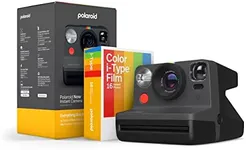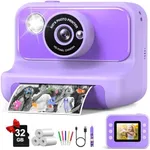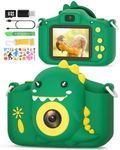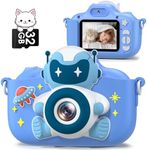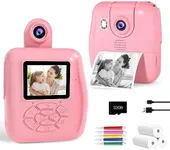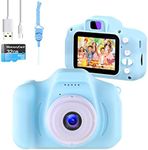Buying Guide for the Best Instant Print Digital Camera
Choosing an instant-print digital camera can be a fun and rewarding experience, especially if you love capturing moments and having physical prints to share. These cameras combine the convenience of digital photography with the nostalgia of instant prints. To find the best fit for you, it's important to consider several key specifications that will impact your overall experience and satisfaction with the camera. Here are the most important specs to consider and how to navigate them.Print QualityPrint quality refers to the clarity, color accuracy, and detail of the photos that the camera produces. This is important because it determines how good your printed photos will look. Print quality can vary based on the camera's resolution and the type of printing technology it uses. Higher resolution cameras (measured in megapixels) generally produce sharper images. Look for cameras with at least 10 megapixels for decent print quality. If you want professional-looking prints, consider cameras with higher resolutions and advanced printing technologies like dye-sublimation or ZINK (Zero Ink).
Print SizePrint size is the physical dimensions of the photos that the camera produces. This is important because it affects how you can use and display your prints. Common print sizes include small (2x3 inches), medium (3x4 inches), and large (4x6 inches). Smaller prints are great for wallets and scrapbooks, while larger prints are better for framing and display. Think about how you plan to use your prints and choose a camera that offers the print size that matches your needs.
Printing SpeedPrinting speed is the amount of time it takes for the camera to produce a physical print after you take a photo. This is important if you want to quickly share prints with friends and family. Printing speeds can range from a few seconds to a couple of minutes. Faster printing speeds are more convenient, especially in social settings. If you plan to use the camera at events or parties, look for models with quicker printing times.
Battery LifeBattery life refers to how long the camera can operate on a single charge. This is important because it affects how many photos you can take and print before needing to recharge. Battery life is usually measured in the number of prints per charge. Cameras with longer battery life are more convenient for extended use, especially when traveling or at events. Consider how often you'll use the camera and choose one with a battery life that suits your needs.
Storage CapacityStorage capacity is the amount of digital memory the camera has for storing photos. This is important because it determines how many photos you can take before needing to transfer or delete them. Some cameras have built-in memory, while others use removable memory cards. Higher storage capacity allows you to take more photos without interruption. If you plan to take a lot of photos, look for cameras with expandable storage options like SD card slots.
ConnectivityConnectivity refers to the camera's ability to connect to other devices, such as smartphones, tablets, or computers. This is important for transferring photos, sharing them on social media, or printing from other devices. Common connectivity options include Bluetooth, Wi-Fi, and USB. If you want to easily share and transfer your photos, look for cameras with good connectivity features. Consider how you plan to use the camera and choose one with the connectivity options that match your needs.
User InterfaceUser interface refers to how easy and intuitive the camera is to use. This is important because it affects your overall experience and how quickly you can take and print photos. Look for cameras with simple, easy-to-navigate menus and controls. Touchscreens can make the user interface more intuitive. If you're new to instant-print digital cameras, choose a model with a user-friendly interface to ensure a smooth and enjoyable experience.
